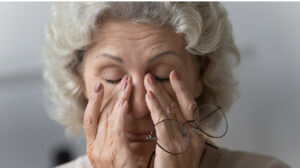 April is Women’s Eye Health and Safety Month, and this year, the focus is on the various diseases and conditions that tend to affect women more so than men. Some of this is due to age-related biological factors such as women living longer than men in nearly every society on the planet, so they have a greater potential to experience vision loss. And the other major reason is that women tend to have less access to quality vision care. The main issues women face more so than men include refractive errors, dry eyes, age-related macular degeneration, cataracts, glaucoma, and thyroid eye diseases.
April is Women’s Eye Health and Safety Month, and this year, the focus is on the various diseases and conditions that tend to affect women more so than men. Some of this is due to age-related biological factors such as women living longer than men in nearly every society on the planet, so they have a greater potential to experience vision loss. And the other major reason is that women tend to have less access to quality vision care. The main issues women face more so than men include refractive errors, dry eyes, age-related macular degeneration, cataracts, glaucoma, and thyroid eye diseases.
Refractive Errors
Refractive errors are conditions where the eye can’t focus clearly. According to the Society for Women’s Health Research (SWHR), 26 percent more women than men account for uncorrected vision loss. The refractive error conditions include:
- Myopia (also known as nearsightedness): Distance vision is blurry.
- Hyperopia (also known as farsightedness): Near vision is blurry.
- Presbyopia (also known as age-related farsightedness): As one ages, near objects become blurry.
- Astigmatism: Where vision can appear wavy due to the curvature of the eye’s lens.
Dry Eyes
Two times more women than men over the age of 50 experience dry eyes. This is largely believed to be due to the onset of menopause.
Age-Related Macular Degeneration
Due to women outliving men, sixty-five percent of individuals in the United States with Age-related Macular Degeneration are women. This condition happens when the center of your vision (not your peripheral vision) becomes blurry, distorted, or blocked and affects your ability to recognize faces, drive, and/or read.
Cataracts
Similarly, 61 percent of people in the United States who develop cataracts, a condition where the lens on the eye becomes cloudy, are women.
Glaucoma
Glaucoma is a disease that causes pressure build-up in the eye that affects vision. Women account for 67 percent of the glaucoma cases in the United States.
Thyroid Eye Disease
Thyroid Eye Disease (TED) is five-to-six times more common in women than in men. TED is an autoimmune condition where the body attacks healthy eye tissue.
Prevention and Detection
Prevention and detection starts with taking care of our bodies, having access to quality food and medical care — and where the eyes are concerned —having a comprehensive eye exam done regularly (every one to two years) will do a long way toward maintaining good eye health.

